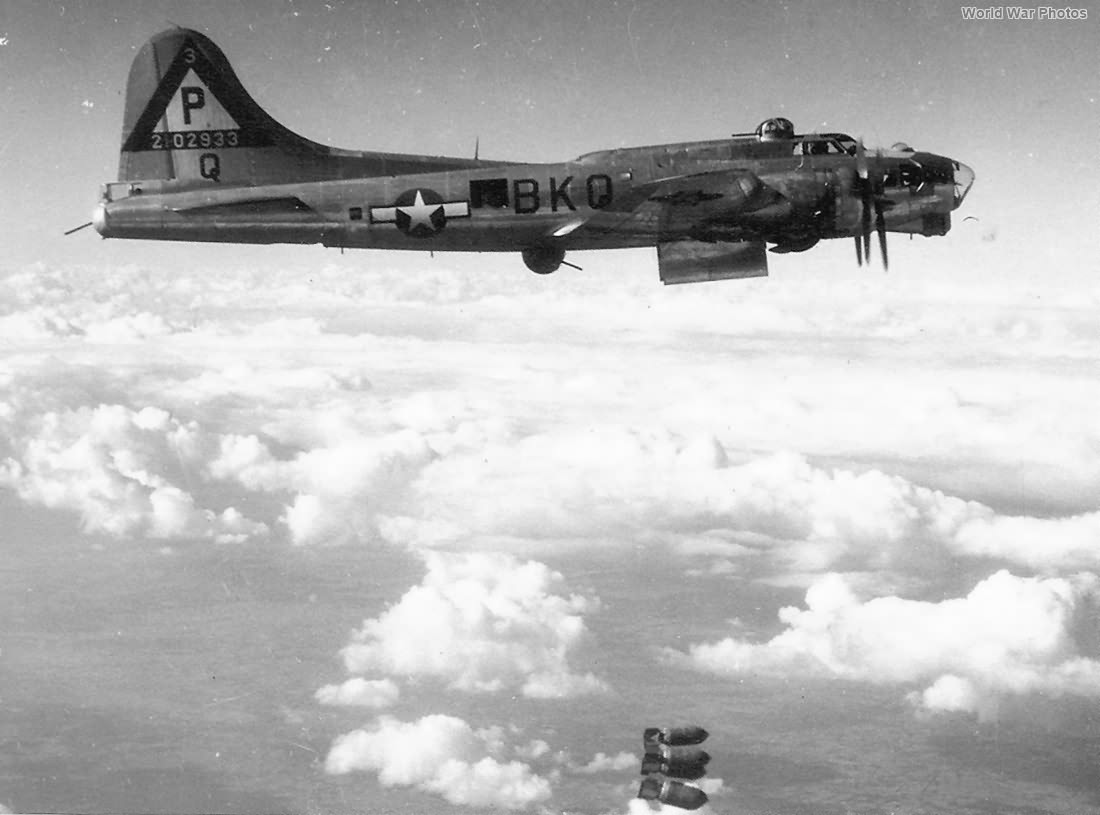384th Bombardment Group (H)
Overview:
- Assigned to Eighth Air Force (8th AF): May 1943
- Primary Aircraft: B-17F and B-17G Flying Fortresses.
- Component Squadrons: 544th, 545th, 546th, and 547th Bombardment Squadrons (H).
Wing & Command Assignments:
- VIII Bomber Command (BC), 1st Bombardment Wing (BW), 103rd Provisional Combat Bombardment Wing (PCBW): June 1943
- VIII BC, 1st Bombardment Division (BD), 41st Combat Bombardment Wing (CBW): September 13, 1943
- 1st BD, 41st CBW: January 8, 1944
- 1st Air Division (AD), 41st CBW: January 1, 1945
Stations:
- Grafton Underwood: May 25, 1943 – June 16, 1945 (Ground echelon arrived June 3, 1943)
Group Commanding Officers:
- Col. Budd J. Peaslee: December 18, 1942 – September 6, 1943
- Col. Julius K. Lacey: September 6, 1943 – November 23, 1943
- Col. Dale R. Smith: November 23, 1943 – October 24, 1944
- Lt. Col. Theodore R. Milton: October 24, 1944 – June 16, 1945
- Lt. Col. Robert W. Fish: June 17, 1945 – October 18, 1945
Combat Record:
- First Mission: June 22, 1943
- Last Mission: April 25, 1945
- Total Missions: 314
- Total Credit Sorties: 9,348
- Total Bomb Tonnage Dropped: 22,415.4 tons (including 16.2 tons of leaflets)
- Aircraft MIA (Missing in Action): 159
- Enemy Aircraft Claims: 165 destroyed, 34 probable, 116 damaged
Major Awards:
- Two Distinguished Unit Citations (DUC):
- January 11, 1944: (Awarded to all 1st Bombardment Division groups)
- April 24, 1944: Oberpfaffenhofen mission
Claims to Fame:
- Dropped the last Eighth Air Force bombs of the war on April 25, 1945.
Early History:
- Activated: December 1, 1942, at Gowen Field, Idaho.
- Training: Began at Wendover, Utah, January 2, 1943 – April 1, 1943. Moved to Sioux City Army Air Base (AAB), Iowa, for final training. The ground echelon left for Camp Kilmer on May 9, 1943, and sailed on the Queen Elizabeth on May 27, 1943, arriving in Greenock on June 2, 1943.
- Air Echelon: Left Sioux City for Kearney, Nebraska, on May 3, 1943, and later in the month began movement to the UK via Bangor, with some flying via Goose Bay and others via Gander. One B-17 ditched in the Atlantic, but the crew was saved. The first B-17s arrived at Grafton Underwood on May 25, 1943.
Subsequent History:
- Post-War Activities: Scheduled for occupational air forces, moved to Istres, France, in June 1945 to participate in the Green Project, moving U.S. troops to staging areas and also transporting displaced persons and Greek military personnel. The group was gradually run down in 1946, with remaining aircraft and personnel absorbed into the 306th Bomb Group.
- Inactivation: The group was inactivated at Istres on February 28, 1946.
Aircraft Markings and Identification:
- B-17F/G Fortresses (May 1943 – June 1945):
- Original B-17Fs were painted in Dark Olive Drab and Neutral Gray factory finishes.
- Squadron Code Letters:
- 544th Bomb Squadron: SU
- 545th Bomb Squadron: JD
- 546th Bomb Squadron: BK
- 547th Bomb Squadron: SO
- The 384th Bomb Group’s squadron code display was known for its inconsistency in the 8th Air Force. The squadron codes were often split, especially noticeable in the 545th and 547th Bomb Squadrons, where the first letter of the code was placed aft of the waist window and the second letter forward of the cocarde, coupled with the individual aircraft call-letter.
- Markings Evolution:
- At first, code letters were painted in bluish-gray, 48 inches high, later reduced to 36 inches in the summer of 1943.
- In June 1943, the Triangle P Group marking was applied to the fin and upper right wing surface, in Insignia Blue on white, following VIII Bomber Command instructions.
- The national insignia change in the late summer of 1943 led to the addition of a call-letter on the fin, painted in yellow below the tail number, 24 inches high.
- When natural metal-finish B-17Gs arrived, fuselage letters were in black, with the Triangle P marking white on black.
- The introduction of the 41st Combat Bomb Wing’s high-visibility markings in August 1944 required the removal of existing tail markings. The new markings featured a 10-foot-sided black triangle with an 18-inch-wide white triangle inside it and a 36-inch high black letter P. Squadron-in-Group numbers (1, 2, 3, or 4) were painted in yellow at the apex.
- In April 1945, squadron colors were introduced on engine cowlings:
- 544th Bomb Squadron: Dark Blue
- 545th Bomb Squadron: Yellow
- 546th Bomb Squadron: Red
- 547th Bomb Squadron: White
- After VE-Day, the group’s aircraft were numbered consecutively from 1 to 71, squadron by squadron, with this number painted on each side of the nose, about 24 inches high. A fuselage cheat line in the squadron color was also applied to many aircraft when fuselage letters were removed. Code letters, applied in mid-May 1945, were retained under the left wing.
